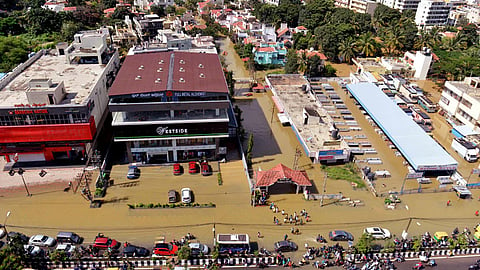

NEW DELHI: In a development that rekindled memories of Chennai’s devastating floods of 2015, parts of Bengaluru were pounded by heavy rain last week, leaving many regions inundated, and hundreds stranded as flood waters entered their homes, while NDRF personnel were pressed into action.
India’s Silicon Valley had experienced its third heaviest rainfall ever recorded in September and it caused floods in parts of the Mahadevapura zone, near KR Puram, and areas such as Whitefield, Bellandur, Yamalur, and residential areas along Sarjapur Road, and Rainbow Colony.
Two people were electrocuted while trying to navigate through an inundated road and a flooded basement, becoming the first, and sadly not the last casualties of ongoing official, corporate apathy, regarding urban planning in India’s big cities.
The response, as expected, was a blame game, where the ruling party pinned the bulk of responsibilities on the erstwhile regime. Karnataka CM Basavaraj Bommai blamed the Congress for maladministration and granting permissions to construct buildings upon encroached lands.
Before the IT boom took over, Bengaluru was known as a city of parks, lakes and tanks, with interconnected channels, not to mention, a pleasant hill station-like weather that lasted year-long.
But, as the demand for real estate space began skyrocketing thanks to the onslaught of software firms, floodplains, that were meant to be safeguarded in case of heavy monsoons, became fair game for real-estate developers, who were ably aided by corrupt municipality officials.
According to a recent study, the vegetation cover in Bengaluru has depleted from 68% in 1973 to a mere 3% in 2020, ignoring the role that trees play in preventing inundation of regions.
Frequent flooding has also been attributed to the loss of interconnectivity between lakes, due to encroachment of storm water drains as well as the dumping of solid and construction waste into such drains.
De-notifying lakes that would have served to recharge the groundwater table, and enabling construction in valleys, wetlands and lake beds have also aggravated the situation.
Concretisation of storm water drains is yet another culprit, and a causative factor that goes hand in hand with the manner in which the quantum of paved surfaces in the city has shot up to 78%, which is likely to become 94% before the end of the year.
We also must account for how big cities have been relied upon as the sole engines of growth, which puts pressure on urban landscapes.
The influx of job seekers into few pockets of urban India such as the major metros, has led to a saturation of real estate requirements, and resources to feed the millions.
Cities like Chennai, Mumbai and Delhi, which have rivers flowing through them, are vulnerable in the event of a weather-related uncertainty and there’s a major requirement to mitigate such concerns on a war footing.
In Chennai, the Corporation is burning the midnight oil to ensure that stormwater drains are constructed/repaired in time, and lakes are desilted before the monsoons. It takes less than an hour of rain for our city to be inundated.
If India is keen on continuing its growth path, we need well-planned capital allocations coming from the Union and State governments to improve our urban infrastructure.
This means extending social and economic infrastructure to smaller cities, so people need not undertake mass migrations.
The key to successful urban planning is decentralisation of governance and delegating powers to corporations and municipalities, giving them the freedom to perform, while keeping in place ecological checks and balances.
Visit news.dtnext.in to explore our interactive epaper!
Download the DT Next app for more exciting features!
Click here for iOS
Click here for Android